CHARLES DARWIN
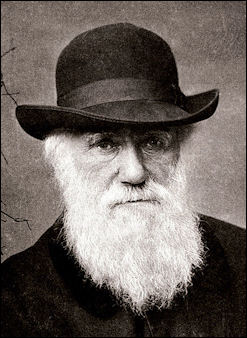
Charles Darwin (1820-1882) in the minds of many people was the greatest scientist of the millennium, making contribution that were more important to mankind and are our understanding of nature than Newton or Einstein. His ideas about evolution are as fundamental to biology and the natural sciences as atoms and molecules are to the fields of physics and chemistry.
Darwin gave the world the theory of natural selection and the concept of survival of the fittest. To appreciate how revolutionary his ideas were, you have to realize that in his time nearly everyone thought that the creatures on earth were exactly the same as the ones created by God on the first day of creation.
Darwin’s discoveries do not come at some great Eureka! moment of profound insight they came after years of collecting as much information about life as he could, spending long hours peering into a microscope and creating a global network of correspondence. To truly appreciate what he did one must realize he worked at time when ships didn’t have engines, the word dinosaur hadn’t been invented and scientists thought disease was caused by “spontaneous generation” — the idea that continuality arose from nonliving things.
Richard Milner, a science historian who played Darwin in a one-man musical “Charles Darwin: Live & In Concert”, told the New York Times, “Everyone should find their own Darwin. The man was so large. He was a zoologist, a botanist, an explorer, a travel writer, a philosopher, an abolitionist, a doting father, a radical intellectual revolutionary with an utterly conservative and blemish-free lifestyle. He revolutionized every field he touched, and was trained in none of them.”
A big deal was made about Darwin in 2009, the 200th anniversary of his birthday and the 150th anniversary of the publication of his groundbreaking book “On the Origin of Species”. To mark these events a replica of the “Beagle”, the ship that carried Darwin around the world, retraced his journey, and movie about his life, “Creation”, was released. In a 2002 BBC poll of great Britons he ranked fourth.
RELATED ARTICLES:
BIODIVERSITY AND THE NUMBER OF SPECIES factsanddetails.com ;
TROPICAL RAINFORESTS: HISTORY, COMPONENTS, STRUCTURE, SOILS, WEATHER factsanddetails.com ;
ANIMALS: TAXONOMY, FEATURES, AND STUDYING THEM factsanddetails.com ;
ANIMALS BEHAVIOR, COUNCIOUSNESS, CHEATING AND NAVIGATION factsanddetails.com ;
LINNAEUS: THE FATHER OF TAXONOMY AND ANIMAL CLASSIFICATIONS factsanddetails.com ;
WORLD'S OLDEST LIFE FORMS: STROMATOLITES, ALGAE AND THROMBOLITES ioa.factsanddetails.com ;
ENDANGERED ANIMALS: NUMBERS, THREATS, HUMANS factsanddetails.com
Darwin's Theory of Evolution
According to Live Science: The Theory of Evolution by natural selection was first formulated in Charles Darwin's book "On the Origin of Species" published in 1859. In his book, Darwin describes how organisms evolve over generations through the inheritance of physical or behavioral traits. The theory starts with the premise that within a population, there is variation in traits, such as beak shape in one of the Galapagos finches Darwin studied. [Source Ashley P. Taylor, Ker Than, Tom Garner, Live Science October 14, 2022]
According to the theory, individuals with traits that enable them to adapt to their environments will help them survive and have more offspring, which will inherit those traits. Individuals with less adaptive traits will less frequently survive to pass them on. Over time, the traits that enable species to survive and reproduce will become more frequent in the population and the population will change, or evolve, according to BioMed Central. Through natural selection, Darwin suggested, genetically diverse species could arise from a common ancestor.
.jpg)
Darwin did not know the mechanism by which traits were passed on. He did not know about genetics, the mechanism by which genes encode for certain traits and those traits are passed from one generation to the next. He also did not know about genetic mutation, which is the source of natural variation. But future research by geneticists provided the mechanism and additional evidence for evolution by natural selection
Darwin chose the term "natural selection" to be in contrast with "artificial selection," in which animal breeders select for particular traits that they deem desirable. In natural selection, it's the natural environment, rather than a human being, that does the selecting. Put simply, the theory of evolution by means of natural selection can be described as "descent with modification," said Briana Pobiner, an anthropologist and educator at the Smithsonian National Museum of Natural History in Washington, D.C., who specializes in the study of human origins. The theory is sometimes described as "survival of the fittest," but that characterization can be misleading, Pobiner said. Here, "fitness" refers not to an organism's strength or athleticism but rather its ability to survive and reproduce.
Natural selection can alter a species in small ways, causing a population to change color or size over the course of several generations, according to The Natural History Museum. When this process happens over a relatively short period of time and in a species or small group of organisms, scientists call it "microevolution." But when given enough time and accumulated changes, natural selection can create entirely new species, a process known as "macroevolution," according to Derek Turner and Joyce C. havstad in "The Philosophy of Macroevolution." This long-term process is what turned dinosaurs into birds, amphibious mammals (such as an animal called Indohyus) into whales and a common ancestor of apes and humans into the people, chimps and gorillas we know today.
For the complete article from which the material here is derived see What is Darwin's Theory of Evolution? Live Science, livescience.com
Darwin, Evolution and Sex
According to The Economist: How the peacock got his tail is one of evolutionary biology's best-known fables. It was first told by none other than Charles Darwin himself. It is, Darwin said, all down to the fickle, female peahen. Because she prefers to mate with males with the flashiest tails, large-tailed males have more offspring. What is less well known is that this theory of sexual selection was created as something of a fudge. Darwin proposed it in response to criticism of his broader theory of evolution by natural selection. That explained how an animal (such as a giraffe) became adapted to its environment through natural variations between individuals. Different neck-lengths in giraffes may confer an advantage on those with the longest necks. [Source: The Economist , February 22, 2003]
The problem with this theory, said Darwin's critics, is that it does not account for animals such as the peacock, the stag beetle and the mandrill, whose males have elaborate and bizarre traits. Far from being adaptations to their environment, these showy traits seem likely to be a disadvantage. Thus, to explain variations between the sexes, Darwin put forward the theory of sexual selection. Females, he said, are the choosy sex; males compete to win female attention. Evolutionary biologists later came to believe that this difference arose from the different size of the gametes—sperm and eggs. Because female gametes are larger than male gametes, females invest more as parents in producing them and so are pickier in their choice of a mate. Males, on the other hand, produce cheap sperm and are promiscuous.
The problem, says Patricia Gowaty, of the University of Georgia, is that the real world does not work like this. At this year's meeting of the American Association for the Advancement of Science (AAAS), in Denver, she explained that her experiments with a number of species, in particular fruit-flies and mice, show that males can be just as picky about their sexual partners as females. Joan Roughgarden, of Stanford University, points out that female monkeys often solicit males and are rebuffed. Why should this be, she asks, if sperm are so cheap?
What worries the minority of scientists who are openly challenging sexual-selection theory is that it is unable to account for much of the diversity of sexual behaviour that exists. If, for example, as sexual-selection theory assumes, mating is primarily about sperm transfer, why do some animals mate between a hundred and a thousand times more often than is needed for conception alone? For animals with strong social structures, the answer could be that mating is a public symbol with social consequences. It is used to create and maintain relationships and alliances, and also to obtain sexual gratification.
Dr Roughgarden, however, believes that the basic mistake is to think that a difference in the size of sperm and eggs translates into differences in behaviour and life history. She says that there are many ways in which animals refute the predictions of sexual selection. For one thing, some fish can make both eggs and sperm during their lifetime, so it is difficult to say categorically that an individual is male or female. Even in such fish as the blue-gilled wrasse, whose biological sex is determined at hatching, gender roles (ie, the behaviours typically associated with one sex or the other) are not. For, besides fish that behave like “normal” males and females, there are “feminised” males—fish that look like females but have male gametes. These reproduce by helping dominant males to mate with females. In doing so, they gain more reproduction opportunities themselves. The society of blue-gilled wrasse is by no means the most complicated in sexual terms. Animal societies with up to three male genders and two female genders have been described. Even when only two genders exist, there are cases where male choice of females is the norm. For example, sea-horse males incubate the young in a special pouch and thus provide parental investment that is worth competing for if you are female.
Most troubling, perhaps, to the theory of sexual selection, is the high incidence of homosexuality. Homosexual behaviour in animals, though well demonstrated in the literature written by scientists who actually observe what animals get up to, has tended to be glossed over by theoreticians. But Paul Vasey, a researcher at the University of Lethbridge in Alberta, Canada, has spent many years studying both theory and practice in Japanese macaques.
Darwin's Early Life
Darwin was born on the same day as Abraham Lincoln: February 12, 1809, which is significant in that both men fought vigorously against slavery. Darwin's father wanted his son to be a doctor or clergyman, and complained that as child he "messed up the house with everlasting rubbish" and cared "for nothing but shooting, dogs and rat catching, and you will be a disgrace to yourself and your family."
Darwin was the grandson of Erasmus Darwin, a noted physician, philosopher, botanist, inventor and poet. Erasmus Darwin was the first naturalist in Europe to publish a coherent theory of evolution. He did this 70 years before Charles Darwin, writing his ideas in verse no less once a week like the book-length poems: “The Temple of Nature” and “Islands and Continent Raised by Earthquakes”. Erasmus believed that life evolved from a single ancestor.”Shall we conjecture that one and the same kind of living filament is and has been the cause of all organic life?” he wrote in “Zoonnomia” in 1794.
Darwin dropped out of medical school in Edinburgh because watching gory operations nauseated him and later enrolled at Cambridge University where he studied theology and began formally studying the natural sciences. He spent his free time collecting beetles.
Darwin, Religion and Geology
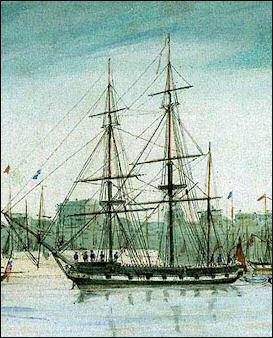
Beagle Darwin initially was a religious man. He was convinced that the study of nature was appropriate for a minster and one of the purposes of his voyage on the “Beagle” was to come up with evidence to support Genesis. Like everyone else in his time, he originally believed the world came into existence in 4004 B.C. (a date determined a 17th century Irish clergyman who chronicled the events of the Bible and came up with date).
Darwin was influenced by Charles Lyell (1797-1875), who applied evolutionary principals to the science of geology to describe the millennia -long processes of erosion, sediment accumulation and volcanism in his book, the “Principals of Geology” . Darwin took the first edition of this book with him on the “Beagle” , along with the Bible and works by Milton and Alexander von Humboldt. The second edition of “Principals of Geology”, which theorized that new species emerged over time while others become extinct, was waiting for Darwin in Montevideo when the “Beagle” arrived.
Darwin's view about religion changed later in life after his beloved daughter Annie died at the age of 10. He wrote that "The beginning of all things is insoluble by us, and I for one must remain an Agnostic." On Sundays his deeply religious wife would go to church and he would go for walks. His last words were reportedly "I am not the least afraid to die."
Darwin Voyages Around the World on the Beagle
In 1831, when Darwin was 22 , he set sail on a round-the-world voyage on the “Beagle” a small 18th-century style boat know as bark, which wasn’t much larger than a present-day tug boat. Its mission was to set up chronometric stations and chart the waters around southern South America and the islands in the South Pacific. Darwin came along as a naturalist whose aim was to find proof for that Bible and Genesis were the literal truth. [Source: Allen Villiers, National Geographic, October 1969]
The voyage was supposed to last for two years, but it lasted for five years. Darwin's father initially didn't want his son to travel around the world on the Beagle, and Charles probably would have stayed home were it not for an uncle who told his father that "the pursuit of Natural History, though certainly not professional, is very suitable to a clergyman."
“The voyage on the Beagle," wrote Charles Darwin, "has been by far the most important event in my life...yet it depended...on such a trifle as the shape of my nose." Robert Fitz Roy, the captain of the Beagle and follower of phrenology, nearly rejected Darwin because his nose suggested a lack of "energy and determination." But because hardly any else was willing to take the nonpaying job of naturalist on a mapping voyage Fitz Roy decided to take the wealthy 22-year-old amateur collector on the trip.
The basic route of the Beagle was as follows: England, the Canary island, three or fours stop each in Brazil, Argentina, and Chile, the Galapagos Islands, Tahiti, New Zealand, Tasmania, Sydney and Albany, Australia, Mauritius, around the Cape of Good Hope, back to Brazil again, and home to England. Darwin wanted to explore Peru at length but a revolution shortened his six week visit there.
The slim six-foot Darwin slept the entire journey in a hammock in the charterhouse on the right end of the poop, the part that rocked the most in turbulent seas. As a result Darwin frequently suffered from awful sickness. In a letter to his sister he wrote: "Heaven protect & fortify my poor stomach." While on board Darwin busied himself reading, writing and examining and classifying the thousands of sample of life he brought on board. When roamed around on land he carried a pistol in his waist coat. They other members of the crew called him "Philos." After his return to England he wrote a popular travelog about the trip.
Darwin, Fossils in Argentina and Galapagos Island Finches
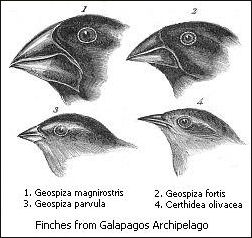
Darwin started having problems with literalist interpretations of the Bible in Argentina when he uncovered fossils of animals that seemed way to large to fit on the Ark. When he brought the skull of the hippopotamus-size toxodon on board the “Beagle” his shipmates complained, "he brought more...rubbish aboard than ten men." It took Darwin a long time however to put all the pieces together. His theory of evolution was not published until 1859, 25 years after the voyage of the Beagle ended.
During Darwin's time the extinction of animals, of which later fossils were found, was explained by occurrences of natural calamities. When Darwin came across some scallop fossils, virtually identical to mollusks of that species found today, he reasoned, that if the present theories of extinction were true then why weren't scalloped wiped out as well. He also saw fossils of horses in Argentina and wondered how it could be they were no horses when Europeans arrived in the New World, but there were horses in the Old World. He was perplexed by woodpeckers in areas with no trees and web-footed geese which never went near the water and was curious about how mice on one side of the Andes could be different from those on the other side
Observing finches on the Galapagos island gave Darwin some of his greatest insighst into evolution. The 13 different species of finches he found there each have a different kind of beak to deal with extracting food in a particular environment. "Seeing the gradation and diversity of structure in one small, small intimately related group of birds, one might really fancy that from an original paucity of birds in this archipelago, once species had been taken and modified for different ends,” he wrote.
Darwin Gets Married and Settles Down
Two years after Darwin returned to England he married one of his cousins, Emma Wedgewood. Before proposing he got out a piece of paper, made a line down the middle and wrote “Marry” on side and “Not Marry” on the other. In the middle he wrote “This is the Question.” On the “Marry” side he wrote things like companionship, children and “charms of music & female chit-chat” and the “Not Marry” side he listed lose freedom and adventure and time to pursue his scientific research. His famous conclusion: “Marry — Marry — Mary Q.E.D.” Quod erat demonstrandum. That it is proven.
Darwin settled into his beloved Down House near Orpington, Kent, 12 miles from London. He never again traveled far from his home. Darwin had 10 children which he loved dearly. He enjoyed reading Mark Twain and Lewis Carrol.
Emma was very religious. Her beloved sister died young and she believed that living a good Christian life would reunite them in heaven. Darwin felt that his growing religious doubts might create problems with his marriage but was open with her about his feelings and they established from what can best be determined a strong and happy relationship. She helped edit and proofread his work and is credited with mellowing the tone of “Origins of Species” so that it didn’t come off as a anti-God diatribe.
Book: “Charles and Emma: The Darwin’s Leap of Faith” by Deborah Heiligman (Henry Holt, 2009)
Origin of Species
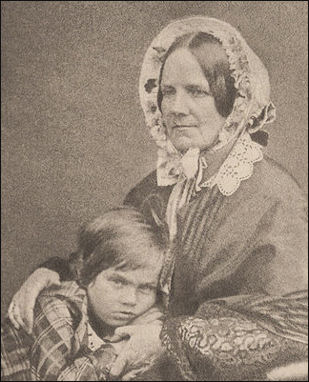
Emma and Leon Darwin Over the years Darwin carefully sorted out the things he observed on the Beagle voyage and combined that with research he did in England and published his two groundbreaking works “On the Origin of Species” and “The Descent of Man” which came out long after the Beagle voyage was over.
Darwin’s theory of evolution first took shape when he made a 35-page outline of his ideas in June 1842. Two years later the work had grown into 230 page abstract but it still wasn’t finished in 1856 when Lyell advised Darwin to "expand his treatment."
In the summer 1858 Darwin received a rude shock when the British naturalist Alfred Russell Wallace sent him an essay from present-day Indonesia describing his theory of the "tendency of varieties to depart indefinitely from the original type," which was basically the same idea of evolution that Darwin himself had been working on for more that 20 years. Darwin put his project in high gear, resulting in the publishing of the “On the Origins of Species” on November 24, 1859.
When Darwin approached his publisher with the idea for the “On the Origin of Species” , the publisher suggested that he write a book about pigeons instead because "Everyone is interested in pigeons." As it was the “Origin of Species” turned out to be a big commercial success. The first 1,250 copies sold out in the first day. In 1876 Darwin wrote "Sixteen thousand copies have now been sold in England, and considering how stiff a book it is this is a large sale. It has been translated into almost every European tongue, even...Spanish, Bohemian, Polish and Russian.”
The full name of the work was “On the Origin of Species by Means of Natural Selection , or the Preservation of Favoured Races in the Struggle for Life”. In it Darwin theorized that: 1) animals reproduce in much greater numbers than can be supported by their environment; 2) the least fit die and the strongest survive; and 3) the properties that allow the fittest to survive are inherited. The term "survival of the fittest" was coined by Herbert Spencer. Darwin also theorized that different species share common ancestry and if you go back far enough you can find these ancestors and that complex traits such as eyesight evolved through a series of intermediate steps. These are plenty of examples in the fossil record to back up Darwin’s theories.
Few people today have read “On the Origin of Species” in the original. It is no easy read but has extraordinary insights especially when the time they are written in are taken into consideration. In it Darwin wrote things like: “What can be more curious than that the hand of man, formed for grasping , the foot of a mole for digging, the leg of a horse, the paddle of a porpoise, and the wing of a bat should all be constructed on the same apparent and should include the same bones in the same relative positions.”
Nicholas Wade wrote in the New York Times, Darwin “thought deeply about every detail of his theory for more than 20 years before publishing “On the Origins of Species”...Instead of brushing off objections to his theory he thought about them obsessively until he had found a solution...Darwin’s thinking about evolution was not only deep, but also very broad. He was interested in fossils, animal breeding, geographical distribution, anatomy and plants.”
Alfred Russell Wallace
Alfred Russell Wallace (1823-1913) developed a theory of evolution the same time as Darwin but failed to win the same recognition as Darwin. He made a historic journey through Malaysia, Borneo and Spice Islands about 20 years after Darwin made his voyage in the Beagle. Wallace was a much more colorful character than Darwin. He was one of nine children in a poor family and dropped out of school at fourteen. His interest in the natural sciences blossomed during beetle-hunting expeditions with a close friend.
Wallace spent fours years collecting specimens in the Amazon. He wrote a paper entitled “On Monkeys in the Amazon” but lost his specimens when the ship he was on caught fire and sunk on the voyage back to Europe. Later in life he became a vocal supporter of women's rights and was a firm believer in Spiritualism. He disputed a theory that the canals on the planet Mars were used by irrigation in his treatise “Is Mars Habitable?”
Wallace collected 125,000 species of flora and fauna, many of them new to science, during his five years in Amazon basin and eight years traveling alone in Indonesia. The idea of survival of the fittest came to him while he was suffering from a malaria fit. Austen Layard, a contemporary of Wallace, said "one of the results of fever is a considerable excitement of the brain."
See Separate Article ASIAN ANIMALS, ALFRED RUSSELL WALLACE AND BIODIVERSITY IN ASIA factsanddetails.com; ALFRED RUSSEL WALLACE ON BIRDS OF PARADISE factsanddetails.com
Darwin and Alfred Russell
.jpg)
Alfred Russell Wallace at 24 Joel Achenbach wrote in the Washington Post: “During a malarial fever in February 1858, Wallace had a revelation about a mechanism that could cause certain traits among species to be favored over time — what would become known as the survival of the fittest. He jotted down his thoughts and mailed a paper outlining his theory to the foremost naturalist of his era: Charles Darwin. [Source: Joel Achenbach, Washington Post, February 8, 2009]
Darwin was aghast. He had been developing his theory of evolution since the 1830s but never published it, fearing that it would cause a great public tumult and undoubtedly upset his extremely devout wife. Now he feared he had been scooped by an obscure bug collector.Darwin's friends came to his rescue. They arranged for a gathering of the Linnean Society of London, where they presented a "joint communication" by Darwin and Wallace, even as the latter was still on the other side of the world. A scientist read an unpublished essay and a private letter written by Darwin that outlined his theory. Then another scientist read Wallace's paper. The event established evolution as a powerful scientific theory; it also established Darwin as having scientific priority. With Wallace's breeze at his back, Darwin quickly finished his masterpiece, "On the Origin of Species," published in 1859.
In his initial letter to Darwin, Wallace wrote: "Why do some die and some live? And the answer was clearly, that on the whole the best fitted live. From the effects of disease the most healthy escaped; from enemies the strongest and swiftest, or the most cunning...Then it suddenly flashed upon me that this self-acting process would necessarily improve the race , because in every generation the inferior would be killed off and the superior would remain — that is the fittest would survive ." Upon reading the letter Darwin wrote his works "were badly written. Mr. Wallace's essay, on the other hand was admirably expressed and quite clear.”
The Linnean Society investigated the matter on who should be given credit for the discovery of evolution. On July 1, 1858, the society announced that "two indefatigable naturalists, Mr Charles Darwin and Mr. Alfred Wallace...independently and unknown to one another, conceived the same very ingenious theory to account for the appearance and perturbation of varieties and of specific forms on our planet." This was the first public statement about the theory of evolution.
Russell eventually gave up on evolution and turned to spiritualism and its weird ideas to explain the human mind. Darwin secretly helped finance the prosecution of a spiritualist con man supported by Wallace. Achenbach wrote: “Wallace was a bit of an eccentric, dabbling in fringe science even after he had made his signal contribution to the revolutionary theory of evolution. Unlike Darwin, he did not believe that natural selection could explain human consciousness. By the end of his life, he was sometimes dismissed as an oddball; only in recent years have scholars come to appreciate his achievements and his centrality in the discovery of evolution.
Wallace never begrudged his fate, and he became Darwin's friend, even using the term "Darwinism" to describe the theory of evolution. At the 50th-anniversary celebration of the 1858 joint communication, Wallace said Darwin deserved the glory. He noted that Darwin had spent two decades developing the theory, while Wallace had spent a week. "I was then, as often since, the 'young man in a hurry'; he, the painstaking and patient student, seeking ever the full demonstration of the truth that he had discovered, rather than to achieve immediate personal fame," Wallace said.
Darwin's Last Years
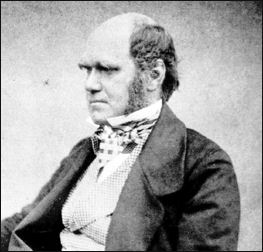
Darwin at 51 Darwin wrote eight books before “Origin of Species” and 10 books afterward. Among his other contributions to science were his explanations that atolls were built by coral reefs left on the remnants of volcano and mountains were created by the uplifting forces of the earth. His later conclusion came from the fact he noticed fossils of sea shells at 14,000 feet in the Andes. He also wrote an influential work on orchids and barnacles.
Darwin's later years were characterized by frequent illnesses, many of them related to Chagas disease, which he picked up in South America. Described by some as a "hypochondriac recluse," he suffered continual pain, sometimes so severe he couldn't work, and psychosomatic headaches. He refused to see people because he said the excitement made him exhausted. His treatments included regular visits to spas, fasting and cutting his intake of snuff
Darwin died in 1882 at the age of 62 of a massive coronary four months after suffering a heart attack. After his heart attack he wrote, "I am not in the least afraid to die...My name ought to last for a few years." He was buried in Westminster Abbey next to Sir Isaac Newton.
Darwin's Legacy
Much of what became the theory evolution came from work after Darwin. Gregor Mendel’s “Patterns of Heredity” gave Darwin’s idea of natural selection a mechanism — genetics — by which it could work. The discovery of DNA gave genetics a mechanism; the development of biology gave DNA a mechanism; and studies documenting evolution in nature transformed the hypothetical into the observable fact. [Source: Carl Safina, New York Times, February 10, 2009]
Nicholas Wade wrote in the New York Times, from a modern perspective, “Darwin’s principal ideas are substantially correct. He did not get everything right. Because he didn’t known plate tectonics, Darwin’s comments on the distribution of species are not very useful. His theory of inheritance, since he no knowledge of genes or DNA is beside the point. But his central concepts of natural selection ad sexual selection were correct, He also presented a form of group-level selection that was long dismissed but now has leading advocates like biologists like E.O. Wilson and David Sloan Wilson...Not only was Darwin correct in the central premises of his theory, but in several other still open issues like his views of how new species form also seem quite like to prevail.”
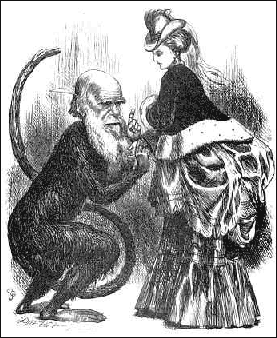
The model for Darwin’s’s theory — the tree of life which views evolutionary development as a nice tidy series of trunks and branches — is less than ideal as it fails to grasp the complexity of evolution with exchanges taking place between branches. Today scientists evolution as being more like a tapestry of woven components than a tree.
Today, biologists along with Google and Adobe, are putting together a modern super tree that will have many animals and plants and show how they are related to other flora and fauna and be accessible to anyone on the Internet. Some hope it will revolutionize the study of the natural sciences the way Google Earth changed the way people looked at geography.
Scientists involved in the project include Michael Sanderson of the University of Arizona and Mark W. Westheats, director of the Biodiversity Synthesis Center at the Field Museum in Chicago. As of early 2009 Stephen Smith of the National Evolutionary Synthesis Center in North Carolina and his colleagues created a tree containing 13,533 species of plant.
Image Sources: Wikimedia Commons
Text Sources: Mostly National Geographic articles. Also David Attenborough books, Live Science, New York Times, Washington Post, Los Angeles Times, Smithsonian magazine, Natural History magazine, Discover magazine, Times of London, The New Yorker, Time, Newsweek, Reuters, AP, AFP, Lonely Planet Guides and various books and other publications.
Last updated November 2024
